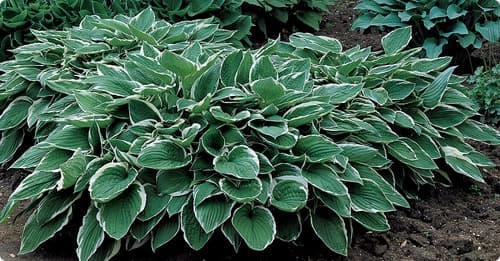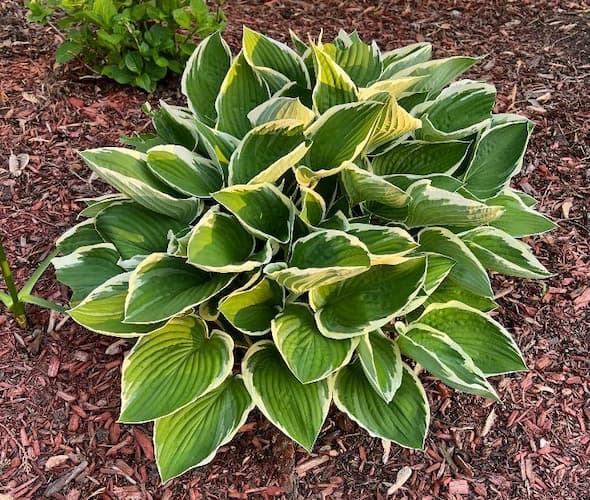How to Grow Hosta Plants

About Growing Hosta Plants in Your Home Flower Garden
Most plants adorning your yard and flower gardens are sun worshippers. And, the selection of sun-loving flowers and plants is vast. When it comes to choosing plants to spruce up those shady areas of your yard, the selection becomes much more limited. Enter the world of attractive Hosta flowers! You will find growing Hosta plants in your shade garden is rewarding. Hosta plants originated in Japan, China, Korea, and other areas of Southeast Asia. Perennial Hostas are members of the Lily family. While the common name for them is Hostas, you may also know them as “Plantain Lily”.
Hosta plants are among the most popular shade-loving plants. There are legions of Hosta lovers and groups. And, rightfully so. Along with their shade-loving nature, there are hundreds of varieties of Hostas to choose from. While they do produce flowers on a long stem, they are primarily grown for their attractive leaves. A low maintenance plant, they grow well under trees, and on the northern side of your house.
Tip: Houseplant lovers…try growing Hostas indoors.
Hosta Plant Specifications
Hosta Flower Colors: While the plants are grown primarily for their attractive foliage, they do produce flowers. Blossom colors include lavender, pink, and white.
Flowers Bloom: Summer
Plant Height: Miniature varieties grow under 9 inches tall. The tallest varieties grow up to 4 feet.
Light Requirements: Light, dappled sun to full shade.
Ideal Soil pH: 6.5 – 7.5.
Hardiness Zone: 3 – 9.
Toxicity: Hostas are non-toxic to humans. However, they are toxic to dogs, cats, and some other animals.
Deer Resistant?: No
Invasive?: Hosta plants are not invasive.
Native To: Asia.
Number of Species: There are 45.
Plant Type: Perennial
Botanical Name: Chrysanthemum maximum (Asteraceae)
Other Names: Plantain Lily

Are Hosta Plants Edible?
YES!!
Humans can eat Hosta plants. In fact, the entire plant is edible for humans. Most people who eat them, prefer the young shoots. Eat them raw or cooked. In some parts of the world, they are grown as a food crop. Try then fresh in salads. There are plenty of recipes on the internet to choose from as you add this plant to your meals.
However, as previously mentioned, Hosta plants are toxic to pets and some animals.
Medicinal Uses for Hostas
In addition to using Hosa plants as a source of food, they have medicinal applications, too.
Ancient Chinese medicine used it to treat a variety of ailments, including:
- Constipation
- High blood pressure
- Skin inflammation and other skin ailments.
Additionally, the leaves and roots of the plant have anti-inflammatory and cancer fighting properties.
Light Requirements
If you’ve got a tree-covered yard, you’re going to love growing Hosta plants. These shade lovers grow well in heavily shaded areas. However, they grow best in areas of your yard that offers dappled shade. A little bit of sunshine, even indirect sunlight, is good for them.
The plants do not like hot and sunny planting locations.
Perennial Hostas Plant Propagation
The majority of gardeners buy plants from their local garden center. Determine where you will place them before you purchase them. The largest varieties need a space that is about 5 feet in diameter. Then, you can determine variety you need to buy for the planting space.
Hostas can be propagated by seed or division. Plant division is by far the most popular method of propagation.
Dig up plants, shoveling deeply with a spade or fork to pull up as many roots as possible. Each plant will have a separate crown and many entangled roots. Loosen the soil, or wash soil off the crown and roots. Carefully divide crowns. You can also divide an individual crown by cutting it with a sharp knife from the top to the bottom of the crown. Try not to cut the roots. Once the crown is cut, separate the roots as best you can. The more roots that remain, the less the transplant shock.
If you are growing Hostas from seed, start them indoors several weeks before the last frost.
How to Grow Hosta Flower Plants
Select a spot with heavy to medium shade. Perennial Hostas prefer loose, well-drained soil. Add some compost and mix well. Plant Hosta roots up to the tops of the crowns spaced two to five feet apart, depending upon variety.
After planting, water well. Keep them well-watered for a few weeks as they grow new roots. Then, keep the soil moist, but not wet during the growing season. Water them occasionally during periods of drought.
Once established, Hostas need little care. Apply general-purpose fertilizer in the spring. Then, if the soil is poor, fertilize the plants once again in mid-summer. The fertilizer promotes bigger and healthier leaves. In average to rich soils, your plants should do well even without adding fertilizers. A layer of mulch will also feed the plant as it decomposes. In addition, mulching around the plants creates a more attractive appearance and helps to retain soil moisture.
Most people grow these plants for their attractive leaves. In midsummer, Hosta plants produce a long stem, also called a “scape” with a flower at the end. You can keep it or remove it, if desired.
Note: Hostas do not like heat. They don’t grow well in the southern parts of the country.
Pruning Hosta Plants
The low-maintenance plant grows well with little or no pruning. Remove any dead or sickly leaves. No other pruning is needed.
After blooming, the stem and spent bloom can be removed. Or, you can leave it on to fully dry. Teen, when it has dried, harvest the seed pods. and harvest the seed pods.
For more information, see: Deadheading spent flowers
Perennial Hostas as Container Plants
Hosta plants are excellent container plants. Use them to brighten up a balcony or patio that is situated on the north side of a building.
Like other container-grown plants, they require extra care.
- Use flowerpots or containers with drain holes in the bottom. This allows excess water to drain so the roots will not rot.
- Keep an eye on the moisture level. Check the plants every day or two, especially in extended periods of hot, dry weather. Keep the soil moist, but not wet. It is okay to let the top of the soil begin to dry between watering. When watering the plants, thoroughly wet the soil. Excess water will drain through the hole in the bottom of the flowerpot.
- Nutrients in a flowerpot are limited. So, use fertilizer spikes to feed the plants. Or, apply a light solution of liquid fertilizer every 4 – 5 weeks.
Winter Care
Perennial Hostas overwinter well in most areas. After frost has killed off the leaves, you can remove the dead leaves to the ground.
In colder areas, add a layer of mulch to keep the roots from being damaged from the ground freezing. Then, in the spring, lightly rake off the mulch.
Insects, Pests, and Plant Disease
While Hosta plants are not totally free of plant problems, you may experience occasional problems.
Slugs and snails will eat holes in the leaves. If they are a problem, treat the area with slug and snail bait.
If present in your area, deer and rabbits will make a meal of the plants. This is especially true, if other food for them is scarce. Fencing is not a solution as it would take away from the appearance of the plant Fortunately, there are a variety of deer and rabbit repellents on the market.
Leaf spot and crown rots occurs in wet weather and wet soil. Keep the leaves dry when watering the plant. To avoid crown rot, dig up the plant and replant it in soil that is slightly elevated.
Also see: Plant Problems – Identify the causes and find the cures.
Related Articles
Also, people who read this article will like:
Plant Problems – Identify the causes and find the cures.
Please support our site. Shop for:
- rmmatthews100@hotmail.com
- 585-721-6528
- Rochester, NY
©1999-2024 GardenersNet.Com, All Rights Reserved

